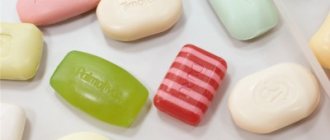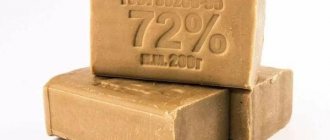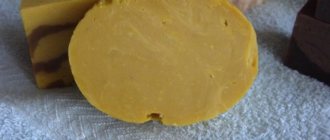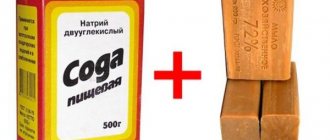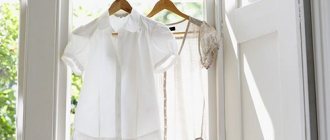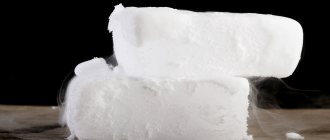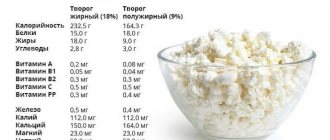Modern industry produces a wide range of detergents of various consistencies, shapes, colors and aroma. Commercials offer new household chemicals from TV screens with enviable regularity. However, practically In every home there will certainly be a piece of laundry soap, often inconspicuous in appearance and not smelling the best. Nevertheless, it is he who helps solve many problems not only at home, but also at the dacha, and in public places.
Chemical composition
Soap contains several main components and a number of additives. Each element has individual characteristics and properties.
Natural fats
Animal fats are the main constituent element. Most often, pork or beef fat is used in production. In rare cases, fatty layers of marine fish are used.
White clay
White porcelain clay, also known as kaolin, is an important ingredient.
Despite its low content, compared to other components, clay softens the alkaline effect on human skin. If there is no kaolin in the composition, you cannot use soap to wash your hair and body.
Sodium
The percentage of sodium in laundry soap is low. Despite this, sodium is a caustic alkali and helps remove stubborn stains during washing.
Fatty acid
As a rule, lauric and palmitic acids are used in production. Due to lauric acid, soap foams well and removes dirt even in cold water. Palmitic acid gives hardness to bar soap. Products with a high content of unsaturated acids have a paste-like consistency.
Water
Fresh water is an essential component of any detergent. The liquid is used at all stages of making laundry soap.
Alkali
Alkali is a basic component in laundry soap. If the alkali content is high, it is not recommended to use hair washing products so as not to damage the hair structure.
Additional Additives
In addition to the standard list of components, soap may contain additives. These include:
- Rosin. The element is found in low grade products. The ingredient improves foaming and dissolution in cold water.
- Salomas. The component is a solid fat that is common in the production of spreads.
- Soapstocks. Substances are formed during the purification of fats with alkaline solutions. If the soap stocks are of high quality, they will make the soap bars harder.
See also
Dimensions and types of waste containers, drawings for the manufacture of tanks
Shaping
The finished soap is quite hard. To give it the required shape, it is first crushed and then pressed. Another option is also possible - the layers are again placed in digesters and melted to a viscous state. After this, the mass is poured into molds and hardens.
The final stage is product labeling. After this, the bars are packed into boxes and sent for sale.
Properties
Laundry soap has several characteristic properties. The presence of these properties determines the prevalence of products in various fields.
Antibacterial action
The ingredients eliminate bacteria that may pose a danger. Due to its antibacterial effect, soap is used for hygiene, washing clothes and cleaning premises .
Antifungal agent
Due to its antifungal properties, many people use soap to treat nail and skin fungus. The products are also suitable for combating mold in the kitchen and bathroom.
Cleansing and whitening properties
The presence of alkali in the composition gives the soap cleansing and whitening properties. These properties are useful when used for washing clothes.
Example
Determine the amount of alkali required to saponify 1000 g of pork fat.
The weight of the oil should be multiplied by the saponification factor: 1000 g × 0.141 = 141 g.
In industry, alkali is used in the form of a 40% solution. For the saponification reaction, the amount of sodium alkali solution required is: 141/0.4 = 352.5 g. If potassium alkali is used, then it will require 1000 g × 0.198/0.4 = 495 g.
Laundry soap is made from waste vegetable or animal oils, the saponification number of which can be within a certain range. When producing soap, the free alkali content in the product is first analyzed, and then the required amount of the missing component is added, and the reaction is completed.
The degree of unsaturation of fats is characterized by the iodine number: the lower it is, the harder the soap is (value below 55) and the longer it is stored.
What do the numbers mean?
The numbers 65, 70 or 72 are indicated on the packaging or on the bar of soap itself. The indication of the category indicates the content of fatty acids. The greater the amount of acids, the better the soap will perform the task.
72%
The best characteristics are found in 72% soap made from animal fats. Without additives, good foaming and high cleaning properties are observed.
70%
Products with the 70% mark differ slightly from the 72% category. It is possible to notice the difference only by weaker foaming.
65%
65% soap often contains rosin. This category is considered low-grade and foams and washes worse.
What is the difference between light and dark
Depending on the exact composition, the finished product acquires a light or dark color. There are also white options with a whitening effect. The main difference you need to be aware of when using it is that the light variety is not suitable for washing dishes.
By shape
Modern manufacturers produce laundry soap in several forms. Each option has its own purpose.
Lumpy
Bar soap is convenient for cleaning various surfaces and rubbing clothes when washing. Also, the lump version is convenient for everyday hand washing.
Liquid
In terms of properties and composition, the liquid version is an alternative to the lump version. Liquid soap is sold in standard plastic containers.
Powdery
Powdered soap can be added to the washing machine or dissolved in a basin and washed clothes by hand. To prevent a strong smell from remaining after washing, it is better to combine the product with conditioner.
Ointment
The presence of a large amount of liquid vegetable fats gives the finished product a paste-like shape. The ointment is convenient to use for treating contaminated, hard-to-reach places.
Equipment
The process of making bars is very simple. It does not require a lot of equipment.
To make soap you need:
- Cooking boilers. Their capacity can range from 50 to 250 liters. During cooking, they do not react with the raw material due to the presence of an inert surface. Sometimes soap making equipment is equipped with a tap. It is located at the bottom and is designed to drain the resulting liquid.
- Melting containers.
- Shredders. Outwardly, they resemble a regular meat grinder. Designed for processing the base.
- Sawing machine. The machine is equipped with rollers that literally rub additional components (flavors, dyes, etc.) into the base. The device is not used if the soap is made using traditional technology.
- Press. Designed to form the base into a continuous strip.
- Cutter. A device that forms finished bars. After this, they are marked and sent for sale.
Thus, in order to organize soap production, complex and expensive equipment is not required.
Application
Laundry soap is used in various areas of everyday life. Its prevalence is due to its unique properties.
Personal hygiene
Gynecologists often advise using laundry soap for intimate hygiene. This is due to the fact that the presence of natural components in the composition eliminates allergic reactions.
See also
How and what is the best way to wash laminate flooring without streaks so that it shines at home
For skin problems
Disinfection properties are useful in the fight against inflammation, acne and pimples. Khozmylo is an analogue of modern foams for washing.
Washing head
Using a hair wash instead of shampoo can eliminate dandruff. In addition, the hair becomes fluffier and softer.
Wash
Clothes made from any materials can be washed well with laundry soap. The product effectively removes dirt and old stains.
ethnoscience
In folk medicine, the product is used to soften the skin on the heels and treat injuries. Use in these situations is possible due to its disinfecting ability.
Cosmetology
In cosmetology, soap is used to care for the skin of the face and body. Washing your face for problem skin promotes healing and makes the epidermis more toned.
Cooking at home
Despite the fact that laundry soap is inexpensive and is consumed very slowly, many people prefer to brew it themselves.
You must first take care of your safety. It is important to remember that making soap involves working with lye. It is necessary to open the windows in the room, put on an old robe and disposable (or rubber) gloves. In addition, it is recommended to purchase a respirator. It will protect the mucous membranes from harmful fumes.
What ingredients will you need:
- 800 g sunflower oil;
- 300 g castor oil;
- 100 g coconut oil;
- 140 g of alkali;
- 330 ml of clean water.
From these components, an average of 1 kg of product is obtained. All soap making products can be purchased in specialized stores. If desired, you can also buy various additives that improve the cleaning properties of the bars.
How to make laundry soap at home:
- Prepare a container for cooking. Place coconut oil in it. It is solid, which means it takes a significant amount of time to become liquid.
- Add sunflower oil to the melted liquid. Stir constantly.
- You need to measure the amount of water and alkali. The latter must be carefully poured into the liquid. In this case, the solution must be stirred constantly. Strain.
- Slowly pour the alkaline solution into the oils. Important! The temperature of the components must be the same. Stir the resulting mass constantly. You can do this using a blender.
- Gradually, marks begin to appear on the thick mass. As soon as this happens, the resulting viscous substance must be placed in a water bath and simmered for 3-4 hours. After this, the mass turns into a substance that looks like a gel.
- Dip the pH strip into it. The resulting value should vary between 8.5-10.
- Add castor oil to the mixture, pour it into molds and cover with film.
The final stage is hardening. In two to three days the soap will be completely ready. Then it should be cut into small cubes.
Best Recipes
There are several known ways to use soap. The recipes are aimed at improving health, hygiene and combating household pollution.
For acne
The product dries out acne upon contact with the skin. It forms an alkaline environment on the skin and has an antibacterial effect.
To strengthen nails
Rubbing your nails with soap helps strengthen them and helps fight fungus. The procedure can be combined with a course of treatment.
Bath for corns
To remove corns, make a bath with soap shavings, soda and hot water. Foot treatment not only eliminates corns, but also gives softness to the heels.
To remove stains from fabric
The alkaline composition effectively removes old stains. Fabrics made from almost any material can be washed.
Greasy dishes
Using soap to wash dishes is a common practice. Active components effectively dissolve fats.
Dishwashing liquid
Laundry soap can serve as an alternative to detergent. It is suitable for both washing greasy dishes and for everyday use.
From boils
The ointment-like consistency is suitable for combating abscesses. For treatment, the affected areas are treated with ointment mixed with grated onion and sugar.
For burns
The effect of the product reduces pain from burns. It is recommended to carry out treatment immediately after receiving a burn.
Production Features
There are several ways to produce products. Each option has distinctive features.
Straight
In the direct method, soap is made from basic ingredients and baking soda is added during the process. The product is boiled until a glue-like substance forms, which is then left to dry.
Indirect
With the indirect method, the salting out procedure is performed. Soap glue is treated with salt, which reduces the amount of fatty acids.
See also
How to clean a chimney (chimney in a private house) from soot with your own hands
Production technology
The industrial process consists of two stages:
- cooking;
- treatment.
At the first stage, the so-called soap glue is obtained. Premium raw materials, such as rendered animal fat, are saponified in a kettle. It is heated, mixed with caustic sodium or potassium, and boiled for several days. Low-quality fatty acids are boiled down and then salted out, freeing and purifying the soap core from unwanted impurities to obtain a high-quality product.
At the second stage, the product is given a marketable appearance: cooling, drying, molding, pressing, cutting, labeling, etc. occurs.
Review of manufacturers
When choosing laundry soap, it will not be superfluous to familiarize yourself with products from various manufacturers. There are many options on the market that have certain features.
Duru
Laundry soap produced by the Duru brand has a universal purpose - from washing clothes to personal hygiene. The product is suitable for use in water of any temperature and does not cause allergic reactions. Due to the presence of glycerin and softening components in the composition, the skin receives additional care. Other advantages include a pleasant smell and affordable cost.
"Stork"
Concentrated product "Stork" is intended for household and industrial use.
The products are high-density, contain glycerin, foam well and contain no fragrances, which makes them versatile.
"Freedom"
Soap called “Freedom” is produced for sanitary and hygienic purposes and for hand washing fabric products. Only natural ingredients are used for production. The main advantages include:
- abundant foaming;
- economical consumption;
- resistance to soaking;
- beneficial effect on the skin;
- hypoallergenic.
"Cinderella"
Powdered detergent “Cinderella” is suitable for washing clothes by hand and in a machine. Degreasing and cleaning properties effectively remove old stains. The product does not destroy the structure of fabrics and restores the saturation and brightness of the material.
"Eared Nanny"
Soap "Eared Nannies" is created for washing children's clothes and is proven hypoallergenic. All types of fabrics can be washed. In case of repeated washing, the whiteness effect is maintained.
"Meridian"
Meridian soap with a fatty acid content of 72% can be used for cleaning premises, washing clothes and washing dishes. The presence of alkali in the composition helps dissolve grease and dirt and has a disinfecting effect. The absence of dyes and fragrances eliminates the occurrence of irritation and allergies.
"Economy"
Liquid antibacterial soap "Economy" is created on the basis of plant raw materials with a concentration of 65%. The product lathers well and is easily washed off with water. The competitive advantage is low cost compared to alternative options.
Haus Frau
The liquid variety of Haus Frau laundry soap is intended for washing hands and kitchen utensils, washing clothes, degreasing and disinfecting. As a rule, the concentration of fatty acids in products of this brand is 72%.
"Sun"
The product called “Sun” has a distinct lemon aroma and is used for hand washing, dishwashing and personal hygiene. During use, a creamy foam is formed that eliminates impurities and is gentle on the skin.
"Antipyatin"
Antipyatin soap is suitable for household use. The product removes old stains from clothing or other surfaces.
Sarma
Sarma products have a whitening effect. A common application is hand washing woven fabrics.
"Spring"
The household product “Spring” effectively cleanses the epidermis. The fatty acid content is 72%.
Decreased immunity
Laundry soap has high antibacterial properties. That is why in the last century it was actively used to wash pets and remove fleas from their fur. For people, regular use of laundry and any other antibacterial soap is dangerous. The epidermis loses its natural protective barrier that protects it from bacteria, overall immunity decreases and the body loses its natural ability to resist harmful microorganisms. This can later lead to skin outbreaks and other infections.
The whole truth: what laundry soap is made from 72
Laundry soap very often has an unsightly appearance and a not very pleasant smell. But this does not prevent many people from using it for washing and cleaning, although modern manufacturers offer a wide selection of cleaning products. Laundry soap is a clean and environmentally friendly product that is not harmful to health and is perfectly used in hot and cold water.
Laundry soap has many useful properties - it perfectly cleanses skin and clothes, and it is also an excellent disinfectant.
Laundry soap 72% is still in great demand today because it is considered an excellent disinfectant and copes well with all kinds of pollution
Laundry soap 72% is the most common soap composition. It has high cleansing and antimicrobial properties. At the same time, the soap does not contain additives or chemicals, which allows you to be sure that it will not cause allergies.
Composition of laundry soap 72%:
- Fatty acid. They are contained in fat, oil and wax of both plant and animal origin.
- Sodium salt. Known as "sour salt".
The quality of soap is affected by its category. Laundry soap 72% has excellent quality indicators. Today you should be careful when purchasing laundry soap. Manufacturers can save on quality ingredients and use substitutes. An interesting fact is that liquid laundry soap has appeared on sale. It is cheap, so it attracts many consumers. But it is worth remembering that real laundry soap can only have a solid form.
How to make laundry soap
Of course, when using laundry soap, you want to know what beneficial properties it has, what is included in its composition and how it is prepared. It is very important to be sure that the product is safe for health. Many people use soap not only for washing and cleaning, but also for cosmetic procedures.
To make soap, they use the fat remaining after tanning the leather, which cannot be used for other purposes.
As a rule, caustic soda and fat are used to make laundry soap.
Soap may also contain soap root. Soap is prepared in special cauldrons in which fats are placed and heated to the desired temperature. After heating, the composition is saponified with caustic soda.
Soap making process:
- Soap glue is prepared from fats and caustic soda. It contains glycerin and soap.
- Soap glue is treated with electrolytes. This leads to delamination of the composition.
- A soap core is formed containing at least 60% acids.
- The bottom layer consists of soap lye, which is formed from glycerin and an electrolyte solution.
There is a legend that the creation of soap began in ancient Rome, when after a sacrifice the fats of burned animals were mixed with ash. This composition was used to clean clothes. Today, the composition of soap varies, as modern manufacturers add additional components to soap in order to improve its properties.
